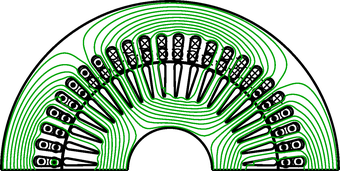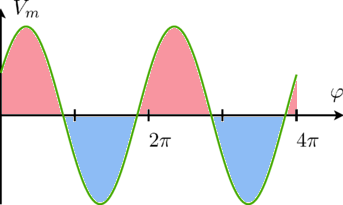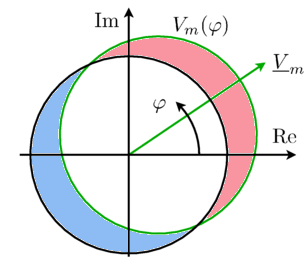 Modelica.Magnetic.FundamentalWave.UsersGuide
Modelica.Magnetic.FundamentalWave.UsersGuide
 Modelica.Magnetic.FundamentalWave.UsersGuide
Modelica.Magnetic.FundamentalWave.UsersGuideThis library contains components for modelling of electromagnetic fundamental wave models for the application in three phase electric machines. DC machines are (currently) not included in this library. The FundamentalWave library is an alternative approach to the Modelica.Electrical.Machines library. A great advantage of this library is the strict object orientation of the electrical and magnetic components that the electric machines models are composed of. From a didactic point of view this library is very beneficial for students in the field of electrical engineering.
For more details see the concept.
Extends from Modelica.Icons.Information (Icon for general information packages).
| Name | Description |
|---|---|
| Fundamental wave concept | |
| Contact | |
| Release Notes | |
| References |
 Modelica.Magnetic.FundamentalWave.UsersGuide.Concept
Modelica.Magnetic.FundamentalWave.UsersGuide.Concept
The exact magnetic field in the air gap of an electric machine is usually determined by an electro magnetic finite element analysis. The waveform of the magnetic field, e.g., the magnetic potential difference  , consists of a spatial fundamental wave - with respect to one pole pair - and additional harmonic waves of different order. The fundamental wave is however dominant in the air gap of an electric machine.
, consists of a spatial fundamental wave - with respect to one pole pair - and additional harmonic waves of different order. The fundamental wave is however dominant in the air gap of an electric machine.

|
In the fundamental wave theory only a pure sinusoidal distribution of magnetic quantities is assumed. It is thus assumed that all other harmonic wave effects are not taken into account.

|
The waveforms of the magnetic field quantities, e.g., the magnetic potential difference  , can be represented by complex phasor, e.g.,
, can be represented by complex phasor, e.g.,  according to:
according to:


|
The potential and flow quantities of this library are the complex magnetic potential difference and the complex magnetic flux as defined in the basic magnetic port. Due to the sinusoidal distribution of magnetic potential and flux, such a complex phasor representation can be used. This way, the FundamentalWave library can be seen as a spatial extension of the FluxTubes library.
The specific arrangement of windings in electric machines with  pole pairs give rise to sinusoidal dominant magnetic potential wave. The spatial period of this wave is determined by one pole pair
[Mueller70,
Spaeth73].
pole pairs give rise to sinusoidal dominant magnetic potential wave. The spatial period of this wave is determined by one pole pair
[Mueller70,
Spaeth73].
The main components of an electric machine model based on the FundamentalWave library are multi phase and single phase windings, air gap as well as symmetric or salient cage models. The electric machine models provided in this library are based on symmetrical three phase windings in the stator and equivalent two or three phase windings in the rotor.
The machine models of the FundamentalWave library are currently based on the following assumptions
The term fundamental wave refers to spatial waves of the electro magnetic quantities. This library has no limitations with respect to the waveforms of the time domain signals of any voltages, currents, etc.
Extends from Modelica.Icons.Information (Icon for general information packages).
 Modelica.Magnetic.FundamentalWave.UsersGuide.Contact
Modelica.Magnetic.FundamentalWave.UsersGuide.Contact
Christian Kral
Austrian Institute of Technology, AIT
Mobility Department
Giefinggasse 2, 1210 Vienna, Austria
email: christian.kral@ait.ac.at
Anton Haumer
Technical Consulting & Electrical Engineering
3423 St. Andrae-Woerdern, Austria
email: a.haumer@haumer.at
Based on an original idea of Michael Beuschel this library was developed [Beuschel00]. The authors of the FundamentalWave library would like to thank Michael Beuschel for contributing his source code to this library.
Extends from Modelica.Icons.Contact (Icon for contact information).
 Modelica.Magnetic.FundamentalWave.UsersGuide.ReleaseNotes
Modelica.Magnetic.FundamentalWave.UsersGuide.ReleaseNotesannotation(Evaluate=true) added to the parameters of the
single phase winding
windingAngle to orientation. The following classes are affected:
modelica:// to all Modelica hyper linksLossPower.png to lossPower.png)tauElectrical, model behavior does not changeExtends from Modelica.Icons.ReleaseNotes (Icon for release notes in documentation).
 Modelica.Magnetic.FundamentalWave.UsersGuide.References
Modelica.Magnetic.FundamentalWave.UsersGuide.References| [Beuschel00] | M. Beuschel, " A uniform approach for modelling electrical machines," Modelica Workshop, pp. 101-108, October 23-24, 2000. |
| [Eckhardt82] | H. Eckhardt, Grundzüge der elektrischen Maschinen (in German), B. G. Teubner Verlag, Stuttgart, 1982. |
| [Haumer09] | A. Haumer, and C. Kral, "The AdvancedMachines Library: Loss Models for Electric Machines," Modelica Conference, 2009. |
| [Li07] | Y. Li, Z. Q. Zhu, D. Howe, and C. M. Bingham, "Modeling of Cross-Coupling Magnetic Saturation in Signal-Injection-Based Sensorless Control of Permanent-Magnet Brushless AC Motors," IEEE Transactions on Magnetics, vol. 43, no. 6, pp. 2552-2554, June 2007. |
| [Mueller70] | G, Müller, Elektrische Maschinen -- Grundlagen, Aufbau und Wirkungsweise (in German), VEB Verlag Technik Berlin, 4th edition, 1970. |
| [Spaeth73] | H. Späth, Elektrische Maschinen -- Eine Einführung in die Theorie des Betriebsverhaltens (in German), Springer-Verlag, Berlin, Heidelberg, New York, 1973. |
Extends from Modelica.Icons.References (Icon for external references).